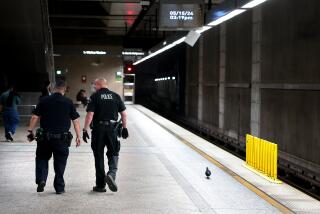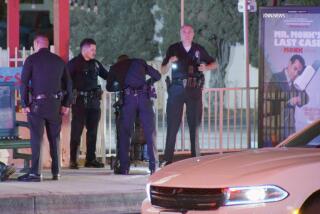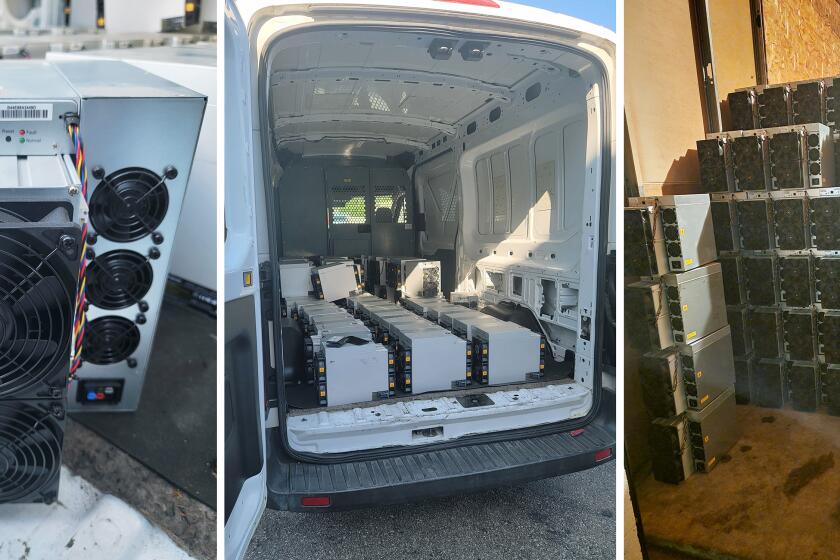In an effort to stem crime, Metro demands fare cards as riders exit station

A new pilot program that forces Metro riders leaving the North Hollywood Station to use their TAP cards to exit is the latest attempt to improve riders’ sense of security after a wave of violent crime.
While some riders welcomed the tactic, others remained skeptical — and some jumped turnstiles to avoid the new rules.
TAP cards are reloadable fare cards used to get into public transit. With most riders earning less than $50,000 a year, the agency has several programs to lower the cost of cards or provide them for free.
Unveiled this week, the 90-day program is aimed at getting people to use their TAP card and discourage riders who use the system for drugs or shelter and often board the trains without paying. It’s paired with increasingly frequent cleaning, more transit officers and a sweeping of the cars, so passengers don’t loiter or pass out on the seats.

“The goal is not to collect more revenue, it is to enforce the rules,” said Stephen Tu, Metro deputy executive officer of station experience. Since its implementation on Tuesday, he said, the Los Angeles County Metropolitan Transportation Authority has logged a 90% increase in fare gate transactions.
Passengers will have to tap to enter and leave, though if they have already paid they will not be charged to exit. Enforcement begins Monday.
Tu explains that the process encourages passengers who may not have entered at a fared gate to purchase their fares.
Those who don’t pay can be subject to a $75 fine.
Law enforcement says most of those arrested on the system haven’t paid their fare. It’s not unusual to see passengers jump over turnstiles or use the emergency doors to get into the system.
“It’s about fare compliance and making sure that the expectations of people coming into the system know that at some point in their journey, they’re going to be checked with their fare,” Tu said.
About half of all rail stations have no fare gate, but Tu said if the pilot goes well, it could be more widely implemented so that a rider might still enter at a station with no fare gate but find that to exit they need to show their card.
On Wednesday around noon, the station was abuzz with passengers and more than a dozen transit officers, Metro ambassadors, private security, LAPD officers, Metro employees and mental health outreach workers .
“There’s more order now. I hope it continues,” said Juana Hernandez de Maya, who takes the B Line to sell used clothes near downtown. “And that’s good because there are drunks, drug users down here.”
And while the station appeared freshly swept, at the top of a long elevator that ascends into the street, a person was curled up on the concrete, drawing on the plaza with their fingers.
Metro is slated to spend $195 million on law enforcement this fiscal year. The former head of Metro security says taxpayers are not getting their money’s worth.
When the person was pointed out to Tu, he noted the plaza was city property and said Metro is trying to do they best it can on its properties. Tu helped bring classical music to the Westlake/MacArthur Park Station to keep people from lingering amid a spate of killings and overdoses last year. Across the street at the Metro G Line stop, a bus connector route, he noted there were several ambassadors, meant to assist riders and help with homeless outreach.
“I would feel better if there was more security at night,” said Lucy Rivera, a 64-year-old hairstylist who takes the train from the Vermont and Santa Monica station to the North Hollywood station in the evening. She wears a mask, she said, because of the smell of urine. She often sees people do drugs on the train or come in drunk.
Over recent years, Metro has poured resources into improving the system. But its sprawling nature has made it challenging, with more than 100 miles of rail and more than 2,000 buses.

Metro is expected to consider creating its own police force, but the agency is also looking at ways that don’t rely solely on more officers, guards or ambassadors, including this TAP test and even facial recognition.
But just how well this test program will work is unclear. On Wednesday, several people jumped the gate as a transit officer stopped a couple.
Brandon Price said he and his wife, Martique, were on the way to pick up their children from school and were questioned after using his child’s TAP card. The card had been issued by his child’s school in South Los Angeles. Metro has been pushing to increase youth riders by providing free TAP cards to students.
Price and his wife, who had recently been homeless, said transit officers confiscated the card. Price purchased another card, but as they headed to the platform, an officer said the two would be banned from taking the train. They did not get a formal citation or anything in writing, but the ban left them scrambling to find transportation home for their children.
“It makes you feel belittled,” Price said. “At least for the rest of the week, we will look for an alternate route.”
The attempt to enforce fares touches on a difficult debate within Metro about equity and the presence of law enforcement. Social justice advocates have argued that too much money is being spent on police and deputies with no stark improvement. They point out that Black riders — which the Prices are — tend to be ticketed more often.

Earlier this month, Mayor Karen Bass ordered a surge of enforcement. At the same time, she affirmed her belief in a fareless public transit system.
Tu said the latter could be possible.
“One of the things we learned from the Westlake/MacArthur Park improvements was the importance of pairing environmental design improvements (like the Tap Out Pilot) with a staffing presence,” he said in an email.
“This could be used in any system, including fareless, in the same way that library cards are used to loan books at no charge to patrons.”
Other major transit systems across the nation already use a similar program, including Bay Area Rapid Transit,
Washington Metropolitan Transit Authority and Metropolitan Atlanta Regional Transit Authority.
Los Angeles City Councilmember Monica Rodriguez, whose Northeast San Fernando Valley district is slated for a new light rail in the coming years and chairs the city’s public safety committee, said this should have already happened.
“How do people respect a system when there is no rules?” she said. Other cities around the world have already adopted this.
“Our communities continue to struggle, and yet they proudly pay their fare on a system that refuses to reinvest to protect them,” she said. “That to me, is just complete an unacceptable failure.”
More to Read
Start your day right
Sign up for Essential California for news, features and recommendations from the L.A. Times and beyond in your inbox six days a week.
You may occasionally receive promotional content from the Los Angeles Times.








